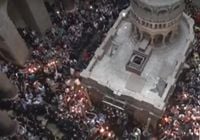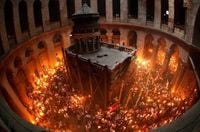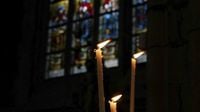Every year, millions of believers eagerly await the descent of the Holy Fire, a significant event that occurs in the Church of the Holy Sepulchre in Jerusalem. This year, the ceremony will take place on April 19, 2025, which is Great Saturday, the eve of Easter. The service in the Church will begin around 12:30 PM Kyiv time, drawing thousands of pilgrims from around the world who wish to witness this miraculous occurrence.
The Holy Fire, also known as the Sacred Light, is a flame that appears in the Holy Sepulchre on Great Saturday, symbolizing the resurrection of Jesus Christ and the triumph of life over death. The descent of the Holy Fire has been celebrated for over 1,500 years, making it a deeply rooted tradition within the Orthodox Christian faith.
During the ceremony, the Jerusalem Patriarch enters the chapel known as the Kuvukliya with candles and 33 additional candles, which represent the number of years Jesus lived before his crucifixion. After a prayer, the Holy Fire is said to descend upon the candles, igniting them in a moment filled with joy and reverence. This moment is typically accompanied by ringing bells and jubilant exclamations from the gathered faithful, creating a profound atmosphere both in the church and among believers worldwide.
As the fire is transported from Jerusalem to various countries, including Ukraine and Russia, it is treated with great respect. Believers often light their own candles from the Holy Fire to take home, sharing its blessings with their communities.
The significance of the Holy Fire is immense, as it symbolizes grace, rebirth, and the victory of light over darkness. For many, witnessing the descent of the Holy Fire is a miraculous event, and its absence could signify impending doom or spiritual decline.
Historically, the first mentions of the Holy Fire date back to the 4th century, when the renowned pilgrim Silvia of Aquitaine documented the presence of lights in the Church of the Holy Sepulchre. However, it was not until the accounts of the Latin pilgrim Bernard in 867 that the Holy Fire was described as a miraculous event. Bernard wrote that the fire descended from heaven after the congregation began singing "Lord, have mercy!" during the Easter vigil.
Throughout the centuries, the tradition of the Holy Fire has faced various interpretations and challenges. During the Crusades, the belief in the descent of the Holy Fire became a symbol of hope for Christians in Jerusalem, especially after the city was captured by Muslim forces. However, the arrival of the Crusaders in 1099 led to a decline in faith regarding the miraculous nature of the fire, as leaders proclaimed that the city had been liberated from non-believers.
In the 17th and 18th centuries, the Armenian and Greek versions of the Holy Fire's legend gained traction. In 1635, Armenian pilgrim Simeon Lehatsi recounted a story where the Holy Fire was said to have descended to the poor outside the temple, leading to a decree allowing them free access to the church. The Greek version, documented by Russian pilgrim Ivan Lukyanov in 1710, described a scenario where Armenians attempted to monopolize the fire's descent, only to be thwarted by divine intervention that favored the Greeks.
The descent of the Holy Fire is not without controversy. Some modern theologians, like Denis Targonsky, argue that the event may not be a divine miracle but rather a ritual with historical roots. The Holy Sepulchre Church has confirmed that a lamp continuously burns within the chapel, from which the Holy Fire is lit. This has led to skepticism about the miraculous claims surrounding the event.
Despite differing opinions, the Holy Fire remains a central aspect of Orthodox Christian tradition, particularly in countries such as Greece, Russia, and Ukraine. The ceremony is broadcasted live on various television channels and online platforms, allowing millions to partake in this sacred event from afar. The broadcast will begin at 1 PM Moscow time on April 19, 2025.
Access to the Church of the Holy Sepulchre will be restricted during the ceremony, with hundreds of police officers and border guards ensuring the safety of the thousands of pilgrims expected to attend. The church will be sealed, and the Jerusalem Patriarch will be searched to ensure he does not carry any means to create fire, maintaining the sanctity of the event.
The ceremony will commence with a procession led by the Armenian Orthodox Patriarch, followed by various rituals that culminate in the lighting of the Holy Fire. The expectations and excitement surrounding this event draw believers from all over the world, eager to witness what they perceive as a divine miracle.
In contrast, the Catholic Church does not have a tradition of the Holy Fire descent. Instead, Catholics celebrate the Easter Vigil with their own rituals that symbolize the resurrection of Christ. This divergence highlights the varied interpretations of fire's significance within different Christian denominations.
As the date approaches, believers prepare to gather in Jerusalem, while millions more tune in online or via television to witness the Holy Fire's descent. For many, it is a moment of spiritual renewal and a powerful reminder of the resurrection's promise. Whether viewed as a miracle or a deeply rooted tradition, the Holy Fire continues to inspire and unite Christians around the globe.








